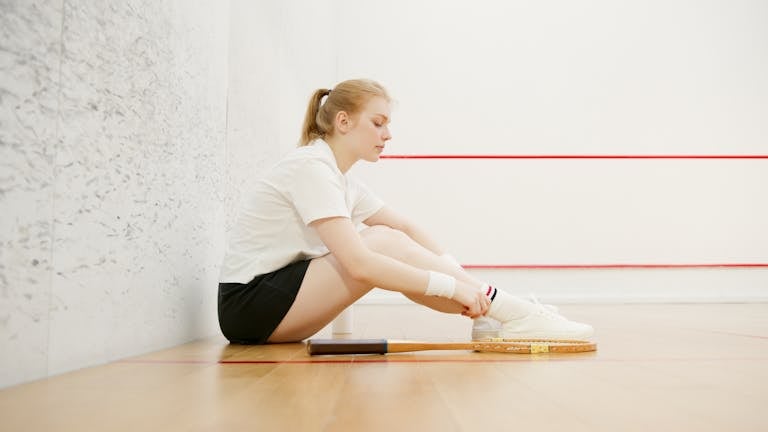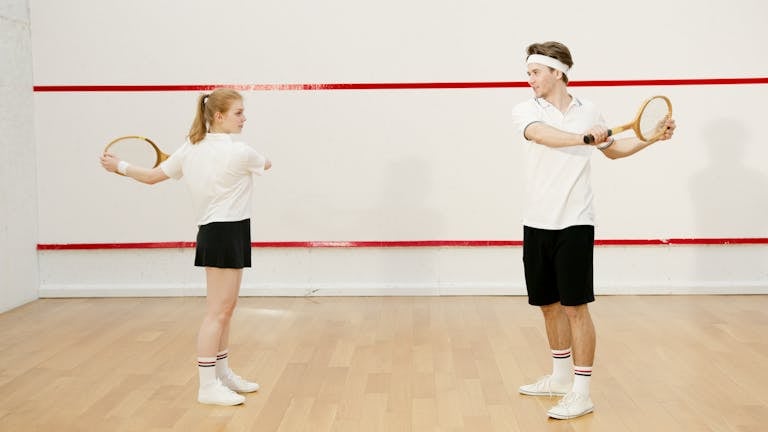Squash game vs racquetball are both exhilarating indoor sports that involve rackets and a ball. Squash vs racquetball is an entirely different discussion.
Unlike racquetball, squash is played on a much smaller, four-walled court with a smaller, less bouncy ball that demands controlled shots and calculated maneuvering. Racquetball courts are a little smaller, no out-of-bounds, and with a bouncier ball, makes for much quicker games.
Squash rackets tend to be longer and narrower, whereas racquetball rackets are shorter rackets with a wider head. These distinctions greatly influence how both sports are played, with squash requiring a more precision and stamina heavy playstyle, and racquetball leaning towards speed and power.
Both sports provide great workout. They entice players of all ages and skill levels and provide personalized experiences like nowhere else.
What Are Squash And Racquetball
 Squash and racquetball are both exciting indoor racquet sports, providing athletes with an amazing combination of strategy, speed, and skill. Though they share similarities, their unique differences in the style of play, equipment used, and court design, such as the standard squash court versus a racquetball court, distinguish them greatly.
Squash and racquetball are both exciting indoor racquet sports, providing athletes with an amazing combination of strategy, speed, and skill. Though they share similarities, their unique differences in the style of play, equipment used, and court design, such as the standard squash court versus a racquetball court, distinguish them greatly.
Definition Of Squash
Squash was first developed in 1830 at Harrow School in England. Players face off on a more intimate court, only 32 feet long, 21 feet wide and 18.5 feet high.
Players compete with a long, narrow racket (27 inches) and a small ball with a 1.57-inch diameter. The sport involves hitting the ball against the front wall inside a marked box, forcing players to develop the skill of accuracy and control.
Agility is key, as players need to be able to react to fast rebounds and change their positioning on the fly. Scoring rules are easy—a game is won by the first player to 11 points, as long as they’re at least two points ahead.
Definition Of Racquetball
Joe Sobek invented the game of racquetball in the 1950s. The game is played on an even bigger court that’s 40-feet long, 20-feet wide and 20-feet high.
It uses a bouncier ball, which is 2.36 inches in diameter. The racquet is shorter, with a teardrop-shaped head that’s 22 inches long.
This design provides for quicker rallies and heavy shots, promoting a more aggressive style of play. Players typically play to 15 points per game, with matches determined in a best of three format.
Key Similarities Between Both Sports
Whether squash or racquetball, both sports boast fast-paced, exciting rallies made possible by four-walled, enclosed courts.
With racquets being an integral part of both sports, skill and technique are paramount, forcing players to focus on shot placement, timing and more.
Whether squash or racquetball, at the heart of either game is the basic premise of out-playing your rivals and earning points, creating an exciting and fun environment.
How Rules Differ In Squash And Racquetball

Even though squash and racquetball share similarities as racquet sports, their contrasting rules create different gameplay mechanics. From rules of play to court design to how the pros engage in competitive play, the two racquet sports provide a vastly different experience.
Scoring System And Gameplay
Squash uses what’s called a point-a-rally scoring system, where every rally results in a point, no matter who served. Matches are played to 11 points, with a need to win by two. This format prevents excessive downtime and upholds the traditional squash value of being rewarded for a good rally.
On the other hand, racquetball is played with a server-only scoring system. Players can only earn points on their serve. This rule introduces an interesting layer of strategy, as players must work to keep control over their serve. Games are usually played to 15 points, except for a tiebreaker game of 11.
These variations affect the flow of play during a match. Squash rewards long, patient rallies and accurate shot placement, whereas racquetball favors hitting the big serve and looking for the fast, early kill.
Court Boundaries And Serving Rules
Squash courts are 32 feet long and 21 feet wide. They go up to an amazing 18.5 feet and have a “tin” at the bottom of the front wall. A serve must land in the other player’s service box and players only get one serve per point. This more intimate, enclosed area requires precision.
In contrast, racquetball courts are much bigger — 40 feet long, 20 feet wide and 20 feet high — and do not have a “tin.” Players serve from any place within the service zone, and get a maximum of two serves per point. This freedom permits a wide range in shot selection and in aggressive rally creation.
Player Movements And Strategies
Squash focuses more on lateral quickness and aerobic capacity. Players have to be able to think on the fly in close quarters, with tactics centered around dominating the T-zone and cutting off opponents’ angles.
While squash focuses on endurance, racquetball emphasizes explosive power and quick change of directions. Players often come out guns blazing with big shots and killer intent to win points. This strategy only works thanks to the extreme ball bounciness and lack of court boundaries.
Comparing Court Dimensions And Equipment

When contrasting squash versus racquetball, the different court dimensions and equipment, including the squash racquet and racquetball racket, are some of the most important factors that define each sport and influence player strategies and playing styles.
| Feature | Squash Court | Racquetball Court |
|---|---|---|
| Length | 32 feet | 40 feet |
| Width | 21 feet | 20 feet |
| Height | 15-19 feet (varies by walls) | 20 feet (24 feet recommended for tournaments) |
| Service Box | No dedicated service boxes | Two 5-foot service boxes |
| Tin Area | Yes (19-inch high metal strip on front wall) | Absent |
Squash Court Layout And Features
A squash court is pretty small, with exact measurements of 32 feet long and 21 feet wide. The front wall is crowned with a tin strip at its base. This strip is 19 inches high and acts as a scoring line.
The serve has to bounce in between the service line and the top edge. Keep in mind, the service line is set at 6’6” above the floor. The back wall height goes down to about 14.5 feet allowing for an interesting completely enclosed space.
The high-quality wood or synthetic surfaces of squash courts provide a consistent ball bounce and let players move quickly in all directions.
Racquetball Court Layout And Features
Racquetball courts are larger too, 40 feet long by 20 feet wide, with a standard height of 20 feet. There is no specific area for tin.
This is where the markings for the serving box and receiving box come in – each service box extends 5 feet from the back wall. The court’s hard surface makes for much faster ball speeds, so speed, agility and quick reaction time are essential.
Differences In Racquets And Balls
Squash racquets are even lighter and shorter than racquetball racquets, which can be up to 22 inches long with a teardrop-shaped head.
Squash balls are a little smaller (1.6 inch in diameter) and racquetballs a good bit bigger (2.36 inches). Squash balls are lower-bounce, needing greater accuracy, while racquetballs are more energetic and thus allow for quick action play.
Historical Origins Of Squash And Racquetball
The historical origins of squash and racquetball provide an intriguing glimpse into how racquet sports are shaped by societal and cultural factors. Both trace their origins to earlier games, taking very different journeys to arrive at the sports we recognize today. Understanding their historical origins offers insight into how squash players and racquetball players engage with their unique racquet sports, their equipment, and their growing popularity worldwide.
Origin Of Squash
Squash can be traced back to the 19th century in England, where it developed among British schoolboys as a leisurely diversion. The sport descended from older handball variants and real tennis, played in walled enclosures. By the early 1700s, inmates at Fleet Prison in London were playing a rudimentary form of real tennis.
Their imaginative play would go on to provide the basis for squash’s development. By the end of the 1920s, squash started to assume a more formal structure. Pierre Etchebaster converted a real tennis court in France into squash courts, creating an official playing space for the sport.
As the game of squash developed, additional elements of strategy and skill were added, and the game quickly became regarded as a distinguished and competitive sport. The development of formal rules and governing bodies further promoted uniformity in the competitive game.
By one account, the Societe Sportive du Jeu de Paume was instrumental in designing the first squash courts. By the 1930s, players such as Abdel Fattah Amr Bey brought the game to new heights, winning British and Egyptian national titles. Squash’s international influence grew quickly, with courts now found in almost 200 countries around the world.
Origin Of Racquetball
Racquetball, in contrast, was an American invention in the 1950s. Pro tennis and handball player Joe Sobek came up with a novel new game. He artistically fused aspects of squash with other racquet games to design it.
His objective was to create a game that was more exciting and simpler to pick up, a game that was less reliant on technical skill. Inspired by squash’s walled courts and handball’s wall-play, Sobek created racquetball with new rules and lighter racquets.
The sport took off like wildfire, particularly during the 1970s and 1980s, as commercial racquetball clubs boomed. Its popularity was largely driven by how accessible it was to the recreational player.
By focusing on fast-paced action, racquetball developed a unique character while still drawing influences from predecessor games.
How Both Sports Evolved Over Time
Both squash and racquetball have experienced significant evolution in their rules and style of play. For squash, the advent of prize-money parity in the 1980s was a response to increased global interest.
In contrast, racquetball developed by optimizing gear, as innovations in materials technology resulted in stronger racquets and more playable courts. International competitions and federations have continued to develop both sports.
Racquetball professional tournaments, such as the British Open for squash, further helped bolster their respective reputations. These efforts have proven to keep the sport fresh and growing, keeping them relevant to today’s audiences.
Physical And Mental Benefits Of Each Sport
Each racquet sport offers its own distinct physical and mental benefits, making both ideal choices for anyone looking to become happier and healthier. Through playing squash or racquetball, participants can improve their physical health, enhance cognitive abilities, and form lasting social bonds within the vibrant squash community. Below, we’ll dive into these benefits one by one.
Physical Fitness Advantages
Squash is a complete and high-intensity workout that poses a challenge to even the most trained cardiovascular system. The non-stop action and bursts of speed increase your heart rate. This high-octane sport increases stamina and can torch a whopping 800 calories an hour!
It builds muscle, especially in the legs, core, and arms, plus helps develop hand-eye coordination and reaction time.
Racquetball focuses more on agility and coordination due to its quick-moving nature. Players are constantly making full-body movements, using all of the leg muscles such as quads, hamstrings, and calves to create powerful explosive movements.
It burns upwards of 700-800 calories an hour. This makes it an incredibly effective tool for weight management and strength development.
Both sports improve your cardiovascular health and increase muscle tone. They offer a unique full-body workout that engages every muscle in your body, from your arms and core to your legs.
Mental Focus And Strategy Benefits
Squash requires serious mental calculation, forcing players to plan their strategy to own the T-zone and have the foresight to outplay opponents. This tactical gameplay promotes critical thinking and focus.
Racquetball, with its intense pace and sudden ball trajectories, demands split-second decision-making and creativity, honing mental agility.
Both sports increase cognitive benefits, like improved concentration. They hone your skill of critical thinking under time pressure, which makes them fun and mentally challenging pursuits.
Social Interaction Opportunities
Squash and racquetball are great ways to meet people. Whether it’s a club or a tournament, esports offers inclusive environments where players connect through common passions, building friendships and professional networking opportunities.
Racquetball’s less-formal environment, especially prevalent in the U.S., creates a more welcoming environment for newcomers and community leagues.
Squash’s international nature makes for a very diverse player pool, further contributing to inclusivity in both sports.
Choosing Between Squash And Racquetball

If you’re deciding between squash and racquetball, consider your fitness objectives and the availability of squash facilities. Think about your playing ability and what you enjoy most. Both racquet sports provide exciting experiences and health benefits, but understanding the court differences can help you make the right choice for your playing sessions.
1. Assess Your Fitness Goals
Squash requires excellent reflexes and footspeed. It takes a high level of continuous stamina, so it’s a great choice for anyone looking for a high-intensity workout!
Racquetball, equally as physically intense, feels more like a game of chess where you’re constantly predicting your opponent’s next move. Both sports improve cardiovascular fitness, agility, and hand-eye coordination.
That said, squash’s quick pace of play might appeal to players looking for a greater level of intensity. When making your decision, think about how these factors will play into what you’re looking to accomplish fitness-wise.
2. Consider Accessibility Of Courts
Accessibility can be an issue, especially if you live in a designated high-poverty area. Squash courts are 32 feet in length and 21 feet in width.
Clubs across the globe showcase these courts, as the game continues to expand at a breathtaking pace in areas such as Asia and South America. Racquetball courts are significantly smaller at 40 feet long and 20 feet wide.
In the U.S., they are more popular, although the number of usage has been falling since the 1980s. Local gyms and sports organizations usually make the call on availability, so checking out facilities in your area is a good first step.
3. Evaluate Skill Level And Preferences
Whatever your level of play and preference, you can enjoy both sports. Squash’s complex tactics and quick pace can be particularly rewarding for people who crave both mental and physical challenges.
Racquetball’s lighter learning curve and focus on fast-paced decision-making may appeal to new players or casual players. Both sports cater to learning and improvement, so starting skill level shouldn’t stop you.
4. Explore Community And Competitions
Squash has a strong international appeal with an active community of 20 million players, providing you with their friendship and extended connections through leagues and tournaments.
Racquetball, with 3.5 million U.S. Players, offers competitive avenues, though not as widely. Meeting more local players, or getting involved with local tournaments and leagues, can make you feel more tied to the game and build friendships that last.
Conclusion of Squash Game vs Racquetball
Squash and racquetball both present their own challenges and rewards. Squash takes that to the next level by requiring extreme accuracy and stamina with its smaller court size and faster pace. Racquetball provides that same power, speed, and reaction time with a more free-flowing feel. Both sports increase health and fitness, enhance concentration, and create mental toughness. Deciding on one over the other usually depends on an individual’s goals and what they prefer to do. Whether you’re a fan of strategic rallies or explosive groundstrokes, there’s action to satisfy every viewer.
If you’re new, it’s worth giving both a shot to find out what works for you. Your local clubs or gyms likely have equipment rentals or beginner practices. Getting started with either sport is an investment in a healthier, more active lifestyle. Therefore, pick up a racquet and get on a court—you’ll find yourself reaping rewards beyond a killer workout.
Frequently Asked Questions
What is the main difference between squash and racquetball?
The gameplay differences between squash and racquetball highlight their unique characteristics; squash utilizes a smaller ball and racquet, while racquetball employs a larger ball and a different style racket, allowing for more aggressive play on various court surfaces.
How do the court sizes compare?
Squash courts, measuring 32 feet long and 21 feet wide, are about a quarter smaller than racquetball courts, which provide a larger playing area at 40 feet long and 20 feet wide.
Which sport is more physically demanding?
Squash, a high-paced racquet sport, tends to be more physical due to the smaller court and faster pace, requiring players to employ strategy consistently during competitive play.
What type of gear is needed for each sport?
Squash needs include a squash racquet, a small rubber squash ball, and non-marking shoes, while racquetball requires a much larger racket, a significantly bouncier ball, and protective goggles for player safety.
Are squash and racquetball good for mental health?
Both racquet sports enhance concentration, quick decision-making, and relaxation, while squash, with its game play complexity, significantly improves strategic thinking for competitive players.
What are the origins of squash and racquetball?
Squash, a popular racquet sport with roots in England in the early 19th century, evolved from a game known as rackets. In contrast, racquetball emerged in the U.S. during the 1950s, blending elements of handball and squash for an immersive playing experience.
How do I decide which sport to play?
Pick squash if you enjoy a quick, tactical match on a standard squash court. Choose racquetball for a less intense, more spacious playing area. Both racquet sports offer a great workout and a good time.


